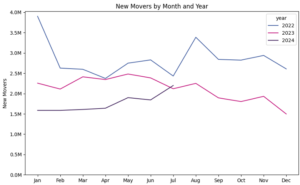The housing market in 2024 has seen significant changes, influenced by economic conditions, demographic shifts, and evolving consumer behaviors. As we delve into the state of new movers and home sales this year, it’s essential to understand the driving forces behind these trends and what they mean for businesses and marketers.
Want to get the latest intel? Then check out our 2025 update.
Economic Conditions and Their Impact
The global economy in 2024 has shown signs of resilience amidst challenges. Inflation rates have stabilized compared to previous years, and interest rates have seen moderate adjustments. These economic factors have played a critical role in shaping the housing market.
Interest rates, in particular, have been a focal point. Lower rates have made mortgages more affordable for many, encouraging first-time homebuyers and those looking to upgrade their living situations. This has led to a noticeable uptick in home sales, particularly in suburban and rural areas where people seek more space and tranquility post-pandemic.
Demographic Shifts: The Rise of the Millennial Homebuyer
One of the most significant demographic shifts influencing the housing market in 2024 is the rise of the millennial homebuyer. Millennials, now in their prime earning years, are increasingly entering the housing market. They bring with them specific preferences and demands, such as a desire for sustainable living, smart home technologies, and proximity to amenities like parks, schools, and shopping centers.
This generation’s approach to home buying is also more digitally oriented. Virtual tours, online mortgage applications, and digital closings have become standard practices, reflecting the broader trend of digital transformation in the real estate industry.
New Movers: Motivations and Trends
New movers in 2024 are driven by various motivations. The desire for more space, the need for home offices, and the appeal of better quality of life in less densely populated areas are some of the primary factors. Additionally, the increased flexibility of remote work has enabled many to move away from urban centers to more affordable and desirable locations.
Moreover, the concept of “forever homes” is gaining traction. Many buyers are now looking for homes that can accommodate long-term living, anticipating potential future needs such as growing families or multigenerational living.
Inventory and Pricing
One possible drag on sales is the increase in house prices. A 5.4% annual gain, according to the latest S&P CoreLogic Case-Shiller Home Price Index three-month running average that ended in June continues to drag on sales (https://www.spglobal.com/spdji/en/index-family/indicators/sp-corelogic-case-shiller/sp-corelogic-case-shiller-composite/#overview ). Until mortgage rates drop and existing homeowners feel more comfortable taking on a new loan they will be unwilling to put their existing homes on the market and inventory will continue to remain restricted.
People who do have their houses on the market and facing a time crunch to move might be pushed in to reducing their sales prices due to a lack of buyers. A recent report by Zillow, showed that about 25% of its listing saw price cut in June (https://www.zillow.com/research/june-2024-market-report-34222/ ), a cut like this hasn’t been seen since 2018. If inventory prices drop this combined with a lower rate might help to push the sales market in the right direction.
Regional Variations in Home Sales
While the overall trend is positive, regional variations are notable. Some regions have seen a surge in home sales, driven by attractive job markets, favorable climate, and lifestyle benefits. States like Texas, Florida, and Arizona continue to see high demand, partly due to their lower cost of living and favorable tax conditions.
On the other hand, some urban centers are experiencing slower growth or even declines in home sales. High costs of living, property taxes, and changes in the desirability of urban living post-pandemic have contributed to this trend.
Upwards Trend
Looking at our own data Speedeon has noticed an upward trend in data volumes for new movers so far this year. As you can see from a relative flat start to the year 2024 has continued an upward trend. Whilst Volumes are still not where they were in 2022 we are now close to where they were at in 2023. If an expected rate reduction by the Fed does happen this month (https://www.cnbc.com/2024/09/05/jpmorgan-top-economist-says-the-fed-should-cut-rates-by-a-half-point-this-month.html ) this should help to spur the lukewarm market and keep the momentum going though out the end of the year.

Implications for Businesses and Marketers
For businesses and marketers, understanding these trends is crucial. The influx of new movers presents opportunities for a wide range of industries, from home improvement and furniture to local services and utilities. Tailoring marketing strategies to cater to the needs and preferences of new homeowners can yield significant returns.
Leveraging data on new movers can help businesses create targeted marketing campaigns. For example, real estate companies can use this data to identify potential buyers and tailor their outreach efforts accordingly. Similarly, local businesses can offer special promotions or services to new residents, helping them settle into their new communities.
Conclusion
The state of new movers and home sales in 2024 reflects broader economic, demographic, and social trends. As the housing market continues to evolve, businesses and marketers must stay attuned to these changes to capitalize on emerging opportunities. By understanding the motivations and preferences of new movers, companies can better serve their needs and drive growth in a competitive landscape.
Speedeon is the industry’s leader in new mover data. If you are looking to reach premovers, movers at contract or new movers, contact marketing@speedeondata.com. Alternatively, book a strategy demo call with an expert, here.

